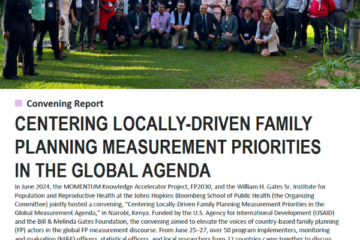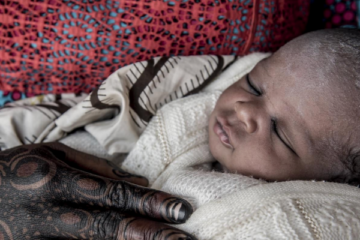
Adolescents in Ga Mashie, Ghana, Share Reasons for Sexual Activity or Abstinence
Date
February 7, 2013
Author
Adriana Biney is a Ph.D. student at the Regional Institute for Population Studies (RIPS), University of Ghana. She is a participant in PRB’s 2012-2013 Policy Communication Fellows Program, funded by USAID through the IDEA project. This article was written as part of the Fellows Program.
(February 2013) Ghana has a young population structure: Close to half of the country’s 25 million people are below age 20, and one in five Ghanaians is an adolescent (ages 10 to 19).1 As adolescents go through puberty and transition into adulthood, sexual and reproductive illnesses will not only affect their well-being as adults but will also affect Ghana’s future population size and economic development.
Adolescents living in urban poor communities are particularly susceptible to sexual and reproductive health challenges because of the combined effects of poverty and urbanization.2 A qualitative study conducted in 2002 in Ga Mashie, an urban poor community in the capital of Accra, illustrates this vulnerability: Girls engaged in sex at early ages, experienced unintended pregnancies, and ended some of those pregnancies with induced abortions.3 This type of information has rarely been collected among adolescents in urban settings.
I am a member of a research team from the University of Ghana that conducted focus group discussions with adolescents ages 12 to 19 in Ga Mashie in 2011. Adolescents noted several factors they believed either encouraged or deterred their engagement in sex. These sex “influencers” and “preventers” were poverty, family, friends, sexually explicit media, positive social institutions (specifically school and church), and personal choice.
The Dynamics of Early Sex in Ghana and Ga Mashie
Understanding adolescents’ views on what encourages or deters sex is important given the average age at first sex in Ghana. Results from the 2008 Ghana Demographic and Health Survey show that over three-quarters of females and close to 60 percent of males in Ghana had their first sexual encounter before age 20. The 2011 Edulink survey conducted in Ga Mashie show comparable results.4 In addition, over 40 percent of girls and about 20 percent of boys ages 15 to 19 in Ga Mashie reported ever having sexual intercourse, similar to national rates; and these data suggest that a large proportion of Ghanaians have sex before age 20, and more females than males start sex during adolescence.
These results point to adolescents’ susceptibility to sexually transmitted infections, including HIV, and the risk of unintended pregnancies—expected outcomes because contraceptive use is low among them, just as in the rest of the Ghanaian population. Unintended pregnancies may result in unsafe induced abortions, unwanted childbearing, and the associated risks of maternal and infant mortality.
Adolescents choose to engage in sex for a variety of reasons. Understanding the reasons for sexual initiation at young ages could lead to programs or interventions better able to delay age at first sex, thus reducing poor health outcomes that result from early sexual initiation.
Factors Influencing Sexual Activity
Our team held eight focus group discussions with boys and girls ages 12 to 14 and 15 to 19, some of whom were in school and some out of school. Participants mentioned a variety of sex influencers and preventers. The table shows that, out of the eight group interviews, four groups mentioned family, two stated personal choice and two reported that positive social institutions were the main sex preventers in the community. Three groups reported that the main sex influencers were poverty; two cited the media; and three mentioned family, personal choice, and friends. A few choices seemed to differ by gender. For instance, only the younger boys cited sexually explicit media and positive social institutions, while it was solely girls who mentioned poverty and personal choice.
Main Sex “Influencers” and “Preventers” Identified by Focus Groups of Adolescents in Ga Mashie, Ghana
|
Number of Focus Groups Identifying
|
||
|---|---|---|
| Sex “Influencers” | Sex “Preventers” | |
| Family | 1 | 4 |
| Personal Choice | 1 | 2 |
| Poverty | 3 | 0 |
| Media | 2 | 0 |
| Friends | 1 | 0 |
| Positive Institutions | 0 | 2 |
Source: Regional Institute for Population Studies, Focus Group Discussions, EDULINK: Urban Health and Poverty Project 2011, Accra, Ghana.
Poverty. Poverty was a key reason for adolescents engaging in sex, as mentioned by three of the groups with girls. One girl noted that children from poor families tend to engage in sex in order to get money. In a community where poverty exists, girls are at risk of engaging in sex for basic necessities (or even for lavish possessions) that their parents cannot provide.5 Once in a relationship, men are expected to provide for women’s needs and women are expected to reciprocate with sex.6
The Media. The next most-mentioned factor falls under the category of sexually explicit media. Both in-school and out-of-school boys ages 12 to 14 mentioned pornography/sexy films as making them curious about and having sex.
The Family. Four out of the eight groups agreed that the family (or parental care/guidance) were essential preventers of sex. One 18-year-old in-school boy said: “…when your parents give you all you need and they love you, you will not need anything from anybody and you will not be influenced into sex.” Studies have shown that parents play a major role in their adolescents’ sexual development.7 These roles may take the forms of parents’ voicing their attitudes toward adolescent sex, encouraging abstinence, or even providing a two-parent home.
Personal Choice. Personal choice was also a key factor that two girls’ groups stated could prevent adolescents from engaging in sex. One 17-year-old out-of-school girl, said: “Whether there is money, parental control, knowledge about sex or not, they have already made up their minds not to engage in sex.”
Understand More About Adolescent Sexual Activity
In order to achieve most of the Millennium Development Goals relevant for sub-Saharan African adolescents, especially in the region’s rapidly developing urban poor communities, we have to understand young people’s needs and experiences. Thus, the findings from these focus groups imply that, in the case of Ga Mashie youth, most strategies being adopted to achieve the MDGs need to be amended to include more parental monitoring and care. In addition, it is important to educate, inform, and counsel adolescents on life skills, tailored to each gender, to enable them to make wise reproductive health choices as they transition to adulthood. Finally, goals to eradicate poverty and hunger affect the prevention of transactional and intergenerational sex, and are crucial to improving adolescent reproductive health among Accra’s urban poor.
References
- Ghana Statistical Service, 2010 Population and Housing Census of Ghana, Summary Report of Final Results (Accra, Ghana: Sakoa Press Limited, 2012).
- Eliya M. Zulu, Francis N. Dodoo, and Alex C. Ezeh, “Sexual Risk-Taking in the Slums of Nairobi, Kenya, 1993-98,” Population Studies 56, no. 3 (2002): 311-23.
- Rebecca Henry and Clara Fayorsey, Coping With Pregnancy: Experiences of Adolescents in Ga Mashi, Accra (Calverton MD: ORC Macro, 2002).
- The EDULINK: Urban Poverty and Health Project was a study conducted in 2009, 2010, and 2011 under the Population Training and Research for Capacity Development (PoPTRCD) project in three localities in Accra (James Town, Ussher Town, and Agbogbloshie). Data shown here are only for those sampled in James Town and Ussher Town (Ga Mashie).
- Francis N. Dodoo, Eliya M. Zulu, and Alex C. Ezeh, “Urban–Rural Differences in the Socioeconomic Deprivation–Sexual Behaviour Link in Kenya,” Social Science & Medicine 64, no. 5 (2007): 1019-31; and Zulu, Dodoo, and Ezeh, “Sexual Risk-Taking in the Slums of Nairobi, Kenya, 1993-98.”
- Augustine Ankomah, “Sex, Love, Money and AIDS: The Dynamics of Premarital Sexual Relationships in Ghana,” Sexualities 2, no. 3 (1999): 291-308.
- Douglas A. Abbott and Rochelle L. Dalla, ” ‘It’s a Choice, Simple as That’: Youth Reasoning for Sexual Abstinence or Activity,” Journal of Youth Studies 11, no. 6 (2008): 629-49.






